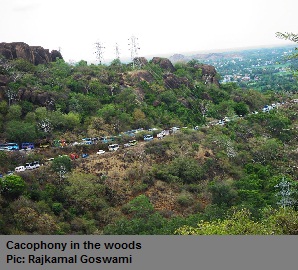Any and all opinions expressed in this newsletter are solely those of the author(s) and do not reflect the opinion of ATREE.
Centre for Excellence in Conservation Science
Royal Enclave,Srirampura,Jakkur Post
Bangalore-560064
Telephone: 080-23635555 (EPABX)
Fax : 080- 23530070
KMTR, although primarily protected for its
biological heritage and diversity, nestles
various religious and cultural enclaves.
Prominent among them is the Sorimuthian
Kovil (SMK), an old temple patronized by the
Singampatti Palayam of the Pandian
dynasty. It has been traditionally managed by
the erstwhile Zamin of Singampatti and the
temple trustees. Even after the notification of
the area as a Tiger Reserve in 1988, the
traditional management authorities were
retained. The temple premises, including the
sanctum sanctorum, cover an area of a few
hectares. It is situated between Papanasam
and Karaiyar Dam, in a serene and secluded
atmosphere. However, the tranquility is
severely tattered during the Adi-Amavasai
festival, falling in the Tamil month of Adi
(between July – August) during which the
Sorimuthian temple attracts an estimated two
lakh visitors. The festival spreads over three
days with preparations for it starting almost a
month earlier. Notwithstanding the religious
rituals and sentiments, the festival also acts as a major socio-cultural fiesta for the people
from the surrounding areas. The festival's huge
congregation also offers an opportune
moment for the erstwhile Zamindar, popularly
known as the Raja of Singampatti, to conduct
a customary durbar during the festival with
high voltage traditional dances and martial
arts being performed in his honor. Muthianar
with his two consorts Poorna and Pushkala is
the main deity to be worshipped, along with
other deities like Sangili Boothathar, Thoosi
Madan, Karadi Madan, Petchi, Isakki,
Pattavarayan and many more deities called
Bootha-kanas. Mahalinga Swamy is
represented in the form of lingam called
‘Swayambulingam’ meaning that it appeared
on its own.
Many folk-stories are attributed to this
temple. Sorimuthian is from the term 'Sori
Muthu Aiyan'. Sori in Tamil means shower,
Muthu in classical Tamil means flowers,
Aiyan represents Aiyanar. The legend is that
Agasthya, while he was worshiping Shiva,
had a gnanadhrishti (divine vision) whereby
he saw Shiva-Parvathi showering flowers
(blessings) on Aiyanar who was worshiping
the Shiva-Parvathi in the location where the temple is located today. Thus, Sorimuthiyan
is popularly known as the Lord who showers
blessings (in the form of rain) in the plateau.
The temple is divided into two, by the
passage of a branch from the main river. A
temple is erected for Pattavarayan, a
Brahmin, and his two wives, belonging to the
cobbler community, a rare example of inter-
caste marriage from yore. According to a
popular legend Lord Pattavarayan, a warrior,
lost his life defending the marauding forces of
bandits trying to take away all the cattle from
the temple-area. His wives perform ‘Sati’
(committing suicide) to join the departed
husband's soul.
The three days of Adi Amavasai period are
celebrated with high festivity. All these rich
and deep-sitting cultural and religious
sentiments results in the gargantuan influx
which includes large number of pilgrims and
cultural tourists. Apart from them, numerous
petty shopkeepers, politicians,
representatives and activists of social welfare
and environmental-protection, and police
also are present in sizeable number.
Although people come from all over Tamil
Nadu, great proportions of the regular pilgrims originate from Alangulam taluk of
Tirunelveli district. While the peak human
presence is seen during the main three days
of the festival, many others extend their stay
beyond it and few even camp up to a month.
Over the years with rapid improvement in
surface transport and communication modes
in the area, there seems to have been an
exponential increase in the presence and
influx of humans particularly during the
festival. With improved camping facilities
and better access, there is an increase in
the number of campers as well as camping
period with the camps spilling over in the
surrounding forest. At ATREE, we have been
trying to balance activism, research and
outreach for the past five years to not only
control, but also negate the adverse impacts
of such a large gathering on the surrounding
forests. However, the greater challenge to
devise ways to counter the impacts without
harming the religious sentiments of the
people remains.
Editorial Team
Editor: Allwin Jesudasan
Associate editor: Rajkamal Goswami
Editorial Review: R. Ganesan, M. Soubadra Devy, T. Ganesh
Design and presentation: Kiran Salegame
A S H O K A T R U S T F O R R E S E A R C H I N E C O L O G Y A N D T H E E
N V I R O N M E N T
Sorimuthian Kovil - past romance and present challenges
- Rajkamal Goswami
If you have any suggestions or comments please let us know through the boxes below






